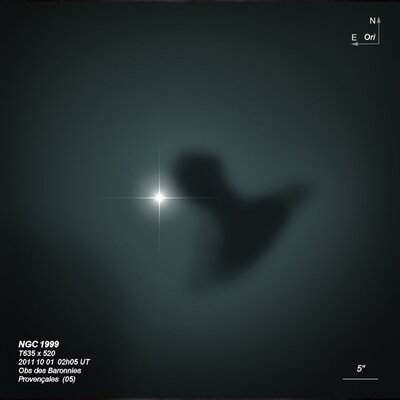
William Herschel discovered NGC 1999 = H IV-33 on 5 Oct 1785 (sweep 458) and called it "a star with a very strong burr all around." On 1 Nov 1785 (sweep 468) he noted "vB or rather a nucleus with a milky nebulosity chiefly on the preceding side, of no very great extent." In his 1814 PT paper WH included NGC 1999 under the section "Of Stars connected with extensive windings of nebulosity" and noted "a star situated upon a ground of extremely faint "milky nebulosity diffused over this part of the heavens, has "a milky chevelure surrounding it, which is brighter than "the nebulosity of the ground; but which loses itself imperceptibly in the extreme faintness of the general diffusion of the nebulous matter." He used this object in his argument that the star was formed by the law of gravitation from the nebular material. His rough sketch shows the off-central star superimposed, though no dark patch. Ralph Copeland, observing with Lord Rosse's 72" on 15 Nov 1873, recorded a "*9m with nebulosity in which there is a vacuity preceding the star. It looks like a comet coiled round into a ring nebula [See Pl I.]. So, clearly the dark patch was quite evident.
Based on photographs taken at the Helwan Observatory in Egypt between 1914-16 with the 30" Reynolds reflector, NGC 1999 was described as "!! vB, pL, a dense globe with an absolutely dark triangular hole cutting into it." Although the dark patch is generally assumed to be a dark globule, a 2010 paper "er ist wahrhaftig ein Loch im Himmel. The NGC 1999 dark globule is not a globule" (http://adsabs.harvard.edu/abs/2010arXiv1005.2202S), suggests that "the dark patch is in fact a hole or cavity in the material producing the NGC 1999 reflection nebula, excavated by protostellar jets from the V 380 Ori multiple system." See http://www.esa.int/esaCP/SEMFEAKPO8G_index_0.html for more.
200/250mm - 8" (11/28/81): small circular nebulosity surrounds a mag 10 star.
300/350mm - 13.1" (2/25/84): a curving dark lane is visible west of the central star with faint nebulosity west of the gap.
400/500mm - 17.5" (2/22/03): remarkable, bright 2' reflection nebula surrounding mag 10.5 V380 Orionis (emission-line star). At 220x, a prominent, curving dark patch or globule wraps around the star along the west side. Two of the brightest Herbig-Haro objects are close south, with HH 2 lies 4.3' due south and fainter HH 1 2.5' is SSW.
17.5" (2/8/90): bright, high surface brightness emission nebula surrounding a mag 10 star, round, about 2' diameter. There is a striking curved irregular dark patch or globule along the west side of the central star that is remarkable at high power. The nebulosity is weakest on the SE side of star. Easily takes 220x-280x.
17.5" (2/22/86): bright, round nebula around a 10th magnitude illuminating star. A eye-catching, curved, irregular dark patch is NW of the central star within the nebulosity.
900/1200mm - 48" (10/25/11): stunning view at 375x and 488x. The high surface brightness reflection nebulosity surrounding the mag 10.5-11.0 illuminating star (V380 Ori) was intensely bright. The dark splotch (possibly a Bok globule) that blots out a portion of the nebula just west of center appeared sharply etched into the nebulosity and formed a "keyhole" or "anvil" outline with a thin extension to the east and a thicker north-south flat section on the west. The contrast of this dark nebulosity was extremely high and appeared virtually identical to images.
Notes by Steve Gottlieb